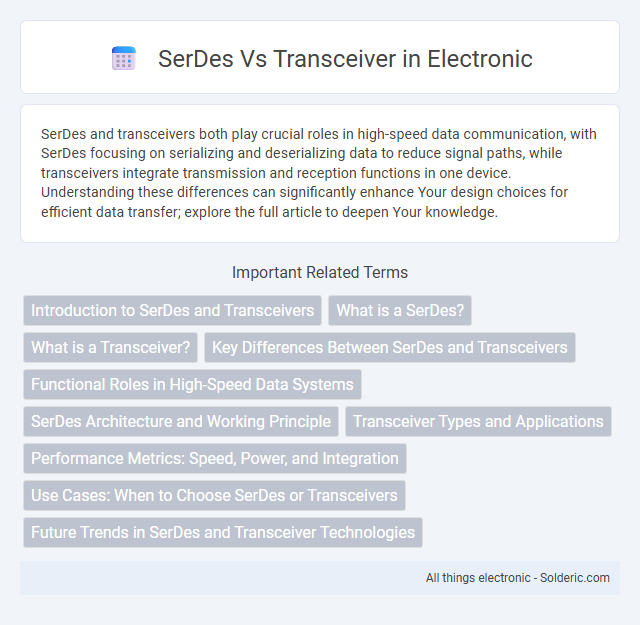SerDes and transceivers both play crucial roles in high-speed data communication, with SerDes focusing on serializing and deserializing data to reduce signal paths, while transceivers integrate transmission and reception functions in one device. Understanding these differences can significantly enhance Your design choices for efficient data transfer; explore the full article to deepen Your knowledge.
Comparison Table
| Feature | SerDes (Serializer/Deserializer) | Transceiver |
|---|---|---|
| Function | Converts parallel data into serial data and vice versa | Handles both transmission and reception of data signals |
| Primary Use | High-speed data serialization for communication links | Full duplex communication over fiber or copper interfaces |
| Components | Serializer + Deserializer units | Transmitter + Receiver + SerDes internally |
| Data Rate | Supports high-speed serial data rates (multi-Gbps) | Supports multi-Gbps data rates depending on design |
| Interface | Serial interface for data transfer | Provides electrical or optical data interface |
| Application | Chip-to-chip data transfer, ASIC communication | Optical modules, Ethernet, fiber channel communication |
| Complexity | Lower complexity, focused on data conversion | Higher complexity with modulation and error handling |
Introduction to SerDes and Transceivers
SerDes (Serializer/Deserializer) and transceivers both play crucial roles in high-speed data communication systems, converting data between serial and parallel forms. A SerDes specifically serializes parallel data for transmission and deserializes received serial data back into parallel form, optimizing bandwidth and reducing I/O pins. Transceivers combine both transmitter and receiver functionalities, enabling bidirectional communication over the same physical medium, which enhances your device's data transfer efficiency.
What is a SerDes?
A SerDes (Serializer/Deserializer) is an integrated circuit designed to convert data between serial and parallel forms, enabling high-speed data transmission over limited wiring. It consolidates multiple parallel data lines into a single serial stream for efficient communication and then converts the serial data back into parallel form at the receiver. SerDes technology is essential in applications such as high-speed communication interfaces, data storage, and telecommunications to reduce pin count and improve signal integrity.
What is a Transceiver?
A transceiver is an integrated device that combines both transmitter and receiver functions into a single unit, enabling bidirectional communication over a communication channel. It plays a critical role in data transmission systems by converting electrical signals into optical or electrical signals and vice versa, facilitating seamless data exchange. Unlike SerDes, which primarily focuses on serialization and deserialization of data streams, transceivers handle the complete signal processing necessary for effective transmission and reception.
Key Differences Between SerDes and Transceivers
SerDes (Serializer/Deserializer) primarily converts data between serial and parallel interfaces to enable high-speed communication, while transceivers integrate both the SerDes functionality and the physical layer for signal transmission and reception. Key differences include that SerDes focuses on data serialization and deserialization without handling the physical signaling, whereas transceivers encompass modulation, encoding, and electrical or optical signal conversion. Transceivers also often support error correction and line equalization, providing a more comprehensive solution for data link communication compared to standalone SerDes blocks.
Functional Roles in High-Speed Data Systems
SerDes (Serializer/Deserializer) plays a crucial role in high-speed data systems by converting parallel data into serial form for transmission and then back to parallel form at the receiver, optimizing signal integrity and bandwidth usage. Transceivers combine both transmitter and receiver functionalities into a single module, enabling bidirectional communication over a single channel with integrated clock and data recovery. While SerDes focuses on data format transformation for efficient transmission, transceivers handle the physical layer interface, modulating and demodulating signals for full duplex data exchange.
SerDes Architecture and Working Principle
SerDes architecture consists of a serializer and a deserializer that convert parallel data into serial data for transmission and then revert it back to parallel form at the receiver end, optimizing high-speed data transfer over limited physical connections. The working principle involves clock data recovery (CDR), where the receiver extracts timing information from the incoming serial data stream to synchronize and accurately reconstruct the parallel data. Transceivers integrate SerDes functionality with additional analog front-end components, enabling bidirectional data transmission, signal amplification, and equalization for enhanced performance in communication systems.
Transceiver Types and Applications
Transceivers come in various types, including SFP, QSFP, and CFP, each designed to support different data rates and distances for applications like data center networking, telecommunications, and high-speed Ethernet. SerDes modules enable high-speed serial communication but typically require separate optical or electrical transceiver interfaces to convert and transmit data over the physical medium. Your choice between SerDes and a specific transceiver type depends on the required bandwidth, signal integrity, and deployment environment.
Performance Metrics: Speed, Power, and Integration
SerDes (Serializer/Deserializer) and Transceivers differ significantly in performance metrics such as speed, power consumption, and integration complexity. SerDes modules excel in high-speed data serialization and deserialization, often supporting multi-gigabit per second rates with lower power usage, making them ideal for efficient, high-bandwidth communication. Transceivers, while also supporting high-speed data transfer, integrate both transmitter and receiver functionalities with added signal conditioning features, which may result in increased power consumption but offer more comprehensive integration for complex networking applications.
Use Cases: When to Choose SerDes or Transceivers
SerDes are ideal for high-speed data serialization and deserialization within chips or between closely integrated components where minimizing pin count and power consumption is crucial. Transceivers are preferred for long-distance communication or when converting electrical signals to optical signals for network transmission, supporting protocols like Ethernet or PCIe. You should choose SerDes for efficient on-chip or board-level data transfer, while transceivers are essential for external communication requiring signal modulation and error correction.
Future Trends in SerDes and Transceiver Technologies
Future trends in SerDes and transceiver technologies emphasize increased data rates exceeding 112 Gbps per lane, driven by AI, 5G, and data center demands. Integration of advanced modulation schemes such as PAM4 and machine learning-based adaptive equalization improves signal integrity and power efficiency. Emerging innovations include co-packaged optics and silicon photonics, which significantly reduce latency and power consumption in high-speed communication systems.
SerDes vs Transceiver Infographic

 solderic.com
solderic.com